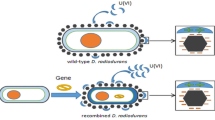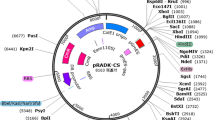Abstract
Strong-reducing gene (dsrA) and the fluorine-resistant gene (flr-2) were cloned into D. radiodurans to prepare a recombinant Deino-dsrA-flr-2 strains. Then, the influencing factors of uranium enrichment by Deino-dsrA-flr-2 and its enrichment mechanism were studied. When the initial concentration of uranium was 30 mg/L, the pH was 5, the biomass was 0.016 g and the enrichment time was 75 min, the Deino-dsrA-flr-2 had the best remove effeciency of U(VI). SEM and TEM could clearly observe uranium deposits on the surface of bacteria; EDS also indicated that uranium appeared on the surface of Deino-dsrA-flr-2. Compared with D. radiodurans, Deino-dsrA-flr-2 can better remove uranium.













Similar content being viewed by others
References
Liu B, Peng T, Sun H, Yue H (2017) Release behavior of uranium in uranium mill tailings under environmental conditions. J Environ Radioact 171:160–168. https://doi.org/10.1016/j.jenvrad.2017.02.016
Chandwadkar P, Misra HS, Acharya C (2018) Uranium biomineralization induced by a metal tolerant Serratia strain under acid, alkaline and irradiated conditions. Metallom Integrat Biomet Sci 10(8):1078–1088. https://doi.org/10.1039/c8mt00061a
Hu N, Ding DX, Li SM, Tan X, Li GY, Wang YD, Xu F (2016) Bioreduction of U(VI) and stability of immobilized uranium under suboxic conditions. J Environ Radioact 154:60–67. https://doi.org/10.1016/j.jenvrad.2016.01.020
Song S, Wang K, Zhang Y, Wang Y, Zhang C, Wang X, Zhang R, Chen J, Wen T, Wang X (2019) Self-assembly of graphene oxide/PEDOT:PSS nanocomposite as a novel adsorbent for uranium immobilization from wastewater. Environ Pollut 250:196–205. https://doi.org/10.1016/j.envpol.2019.04.020
Zhang S, Wang J, Zhang Y, Ma J, Huang L, Yu S, Chen L, Song G, Qiu M, Wang X (2022) Applications of water-stable metal-organic frameworks in the removal of water pollutants: a review. Environ Pollut 291:118076. https://doi.org/10.1016/j.envpol.2021.118076
Kolhe N, Zinjarde S, Acharya C (2018) Responses exhibited by various microbial groups relevant to uranium exposure. Biotechnol Adv 36(7):1828–1846. https://doi.org/10.1016/j.biotechadv.2018.07.002
Wufuer R, Wei Y, Lin Q, Wang H, Song W, Liu W, Zhang D, Pan X, Gadd GM (2017) Uranium bioreduction and biomineralization. Adv Appl Microbiol 101:137–168. https://doi.org/10.1016/bs.aambs.2017.01.003
Chen T, Zhang J, Li M, Ge H, Li Y, Duan T, Zhu W (2019) Biomass-derived composite aerogels with novel structure for removal/recovery of uranium from simulated radioactive wastewater. Nanotechnology 30(45):455602. https://doi.org/10.1088/1361-6528/ab3991
Dinocourt C, Legrand M, Dublineau I, Lestaevel P (2015) The neurotoxicology of uranium. Toxicology 337:58–71. https://doi.org/10.1016/j.tox.2015.08.004
Yu S, Pang H, Huang S, Tang H, Wang S, Qiu M, Chen Z, Yang H, Song G, Fu D, Hu B, Wang X (2021) Recent advances in metal-organic framework membranes for water treatment: a review. Sci Total Environ 800:149662. https://doi.org/10.1016/j.scitotenv.2021.149662
Foster RI, Kim KW, Oh MK, Lee KY (2019) Effective removal of uranium via phosphate addition for the treatment of uranium laden process effluents. Water Res 158:82–93. https://doi.org/10.1016/j.watres.2019.04.021
Wang XL, Li Y, Huang J, Zhou YZ, Li BL, Liu DB (2019) Efficiency and mechanism of adsorption of low concentration uranium in water by extracellular polymeric substances. J Environ Radioact 197:81–89. https://doi.org/10.1016/j.jenvrad.2018.12.002
Chang HS, Buettner SW, Seaman JC, Jaffé PR, van Groos PG, Li D, Peacock AD, Scheckel KG, Kaplan DI (2014) Uranium immobilization in an iron-rich rhizosphere of a native wetland plant from the Savannah River Site under reducing conditions. Environ Sci Technol 48(16):9270–9278. https://doi.org/10.1021/es5015136
Yu S, Tang H, Zhang D, Wang S, Qiu M, Song G, Fu D, Hu B, Wang X (2021) MXenes as emerging nanomaterials in water purification and environmental remediation. Sci Total Environ 10(811):152280. https://doi.org/10.1016/j.scitotenv.2021.152280
Mkandawire M (2013) Biogeochemical behaviour and bioremediation of uranium in waters of abandoned mines. Environ Sci Pollut Res Int 20(11):7740–7767. https://doi.org/10.1007/s11356-013-1486-3
Mumtaz S, Streten C, Parry DL, McGuinness KA, Lu P, Gibb KS (2018) Soil uranium concentration at ranger uranium mine land application areas drives changes in the bacterial community. J Environ Radioact 189:14–23. https://doi.org/10.1016/j.jenvrad.2018.03.003
Wen L, Yue L, Shi Y, Ren L, Chen T, Li N, Zhang S, Yang W, Yang Z (2016) Deinococcus radiodurans pprI expression enhances the radioresistance of eukaryotes. Oncotarget 7(13):15339–15355. https://doi.org/10.18632/oncotarget.8137
Xu R, Wu K, Han H, Ling Z, Chen Z, Liu P, Xiong J, Tian F, Zafar Y, Malik K, Li X (2018) Co-expression of YieF and PhoN in Deinococcus radiodurans R1 improves uranium bioprecipitation by reducing chromium interference. Chemosphere 211:1156–1165. https://doi.org/10.1016/j.chemosphere.2018.08.061
Tapia-Rodriguez A, Tordable-Martinez V, Sun W, Field JA, Sierra-Alvarez R (2011) Uranium bioremediation in continuously fed upflow sand columns inoculated with anaerobic granules. Biotechnol Bioeng 108(11):2583–2591. https://doi.org/10.1002/bit.23225
Abdelouas A, Lutze W, Gong W, Nuttall EH, Strietelmeier BA, Travis BJ (2000) Biological reduction of uranium in groundwater and subsurface soil. Sci Total Environ 250(1–3):21–35. https://doi.org/10.1016/s0048-9697(99)00549-5
Orellana R, Leavitt JJ, Comolli LR, Csencsits R, Janot N, Flanagan KA, Gray AS, Leang C, Izallalen M, Mester T, Lovley DR (2013) U(VI) reduction by diverse outer surface c-type cytochromes of Geobacter sulfurreducens. Appl Environ Microbiol 79(20):6369–6374. https://doi.org/10.1128/aem.02551-13
Lakaniemi AM, Douglas GB, Kaksonen AH (2019) Engineering and kinetic aspects of bacterial uranium reduction for the remediation of uranium contaminated environments. J Hazard Mater 371:198–212. https://doi.org/10.1016/j.jhazmat.2019.02.074
Fredrickson JK, Kostandarithes HM, Li SW, Plymale AE, Daly MJ (2000) Reduction of Fe(III), Cr(VI), U(VI), and Tc(VII) by Deinococcus radiodurans R1. Appl Environ Microbiol 66(5):2006–2011. https://doi.org/10.1128/aem.66.5.2006-2011.2000
Shen J, Schäfer A (2014) Removal of fluoride and uranium by nanofiltration and reverse osmosis: a review. Chemosphere 117:679–691. https://doi.org/10.1016/j.chemosphere.2014.09.090
Zhang P, He Z, Van Nostrand JD, Qin Y, Deng Y, Wu L, Tu Q, Wang J, Schadt CW, Fields MW, Hazen TC, Arkin AP, Stahl DA, Zhou J (2017) Dynamic succession of groundwater sulfate-reducing communities during prolonged reduction of uranium in a contaminated aquifer. Environ Sci Technol 51(7):3609–3620. https://doi.org/10.1021/acs.est.6b02980
Pan W (2011) Construction of fluorine-resistant genetically engineered bacteria with leaching microorganism Thiobacillus ferrooxidans. University of South China, Master
Kulkarni S, Ballal A, Apte SK (2013) Bioprecipitation of uranium from alkaline waste solutions using recombinant Deinococcus radiodurans. J Hazard Mater 262:853–861. https://doi.org/10.1016/j.jhazmat.2013.09.057
Appukuttan D, Seetharam C, Padma N, Rao AS, Apte SK (2011) PhoN-expressing, lyophilized, recombinant Deinococcus radiodurans cells for uranium bioprecipitation. J Biotechnol 154(4):285–290. https://doi.org/10.1016/j.jbiotec.2011.05.002
Manobala T, Shukla SK, Rao TS, Kumar MD (2019) A new uranium bioremediation approach using radio-tolerant Deinococcus radiodurans biofilm. J Biosci 44 (5)
Baiget M, Constantí M, López MT, Medina F (2013) Uranium removal from a contaminated effluent using a combined microbial and nanoparticle system. New Biotechnol 30(6):788–792. https://doi.org/10.1016/j.nbt.2013.05.003
Ding L, Tan WF, Xie SB, Mumford K, Lv JW, Wang HQ, Fang Q, Zhang XW, Wu XY, Li M (2018) Uranium adsorption and subsequent re-oxidation under aerobic conditions by Leifsonia sp.—Coated biochar as green trapping agent. Environ Pollut 242(Pt A):778–787. https://doi.org/10.1016/j.envpol.2018.07.050
Wang S, Shi L, Yu S, Pang H, Qiu M, Song G, Fu D, Hu B, Wang X (2022) Effect of Shewanella oneidensis MR-1 on U(VI) sequestration by montmorillonite. J Environ Radioact 242:106798. https://doi.org/10.1016/j.jenvrad.2021.106798
Abostate MA, Saleh Y, Mira H, Amin M, Al Kazindar M, Ahmed BM (2018) Characterization, kinetics and thermodynamics of biosynthesized uranium nanoparticles (UNPs). Artific Cells Nanomed Biotechnol 46(1):147–159. https://doi.org/10.1080/21691401.2017.1301460
Liu R, Wang H, Han L, Hu B, Qiu M (2021) Reductive and adsorptive elimination of U(VI) ions in aqueous solution by SFeS@Biochar composites. Environ Sci Pollut Res 28(39):55176–55185. https://doi.org/10.1007/s11356-021-14835-0
Liu F, Hua S, Wang C, Hu B (2022) Insight into the performance and mechanism of persimmon tannin functionalized waste paper for U(VI) and Cr(VI) removal. Chemosphere 287(Pt 3):132199. https://doi.org/10.1016/j.chemosphere.2021.132199
Phyo AK, Jia Y, Tan Q, Sun H, Ruan R (2020) Competitive growth of sulfate-reducing bacteria with bioleaching acidophiles for bioremediation of heap bioleaching residue. Int J Environ Res Public Health 17(8):2715. https://doi.org/10.3390/ijerph17082715
Yang H, Liu X, Hao M, Xie Y, Wang X, Tian H, Waterhouse GIN, Kruger PE, Telfer SG, Ma S (2021) Functionalized iron-nitrogen-carbon electrocatalyst provides a reversible electron transfer platform for efficient uranium extraction from seawater. Adv Mater 33(51):e2106621. https://doi.org/10.1002/adma.202106621
Cheng G, Zhang A, Zhao Z, Chai Z, Hu B, Han B, Ai Y, Wang X (2021) Extremely stable amidoxime functionalized covalent organic frameworks for uranium extraction from seawater with high efficiency and selectivity. Sci Bull 66(19):1994–2001. https://doi.org/10.1016/j.scib.2021.05.012
Weng Y, Li J, Ding X, Wang B, Dai S, Zhou Y, Pang R, Zhao Y, Xu H, Tian B, Hua Y (2020) Functionalized gold and silver bimetallic nanoparticles using Deinococcus radiodurans protein extract mediate degradation of toxic dye malachite green. Int J Nanomed 15:1823–1835. https://doi.org/10.2147/ijn.S236683
Yang J, Dong FQ, Dai QW, Liu MX, Nie XQ, Zhang D, Ma JL, Zhou X (2015) [Biosorption of radionuclide uranium by Deinococcus radiodurans]. Guang pu xue yu guang pu fen xi = Guang pu 35 (4):1010–1014
Li J, Li Q, Ma X, Tian B, Li T, Yu J, Dai S, Weng Y, Hua Y (2016) Biosynthesis of gold nanoparticles by the extreme bacterium Deinococcus radiodurans and an evaluation of their antibacterial properties. Int J Nanomed 11:5931–5944. https://doi.org/10.2147/ijn.S119618
Kim HK, Jeong SW, Yang JE, Choi YJ (2019) Highly efficient and stable removal of arsenic by live cell fabricated magnetic nanoparticles. Int J Mole Sci. https://doi.org/10.3390/ijms20143566
Misra CS, Mukhopadhyaya R, Apte SK (2014) Harnessing a radiation inducible promoter of Deinococcus radiodurans for enhanced precipitation of uranium. J Biotechnol 189:88–93. https://doi.org/10.1016/j.jbiotec.2014.09.013
Acknowledgements
This work was supported by the Hunan Province Natural Science Foundation of China (Grant Numbers 2020JJ6050 and 2020JJ4077).
Author information
Authors and Affiliations
Corresponding authors
Ethics declarations
Conflict of interest
We declare that no known conflict of interest that could have appeared to influence the work reported in this paper.
Additional information
Publisher's Note
Springer Nature remains neutral with regard to jurisdictional claims in published maps and institutional affiliations.
Rights and permissions
About this article
Cite this article
Li, S., Xie, J., Luo, J. et al. Research on the effect of Deinococcus radiodurans transformed by dsrA-flr-2 double gene on the enrichment performance of uranium(VI). J Radioanal Nucl Chem 331, 2195–2207 (2022). https://doi.org/10.1007/s10967-022-08257-6
Received:
Accepted:
Published:
Issue Date:
DOI: https://doi.org/10.1007/s10967-022-08257-6




